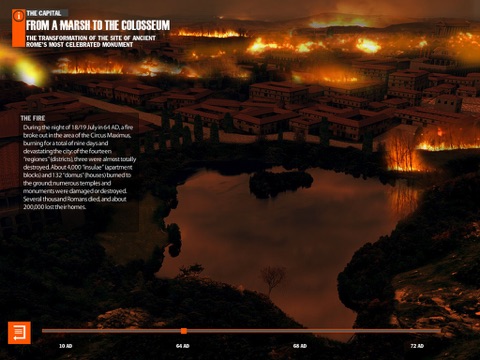
Virtual History - Roma app for iPhone and iPad
Developer: Applix srl
First release : 20 Jan 2011
App size: 201.52 Mb
Mondadori presents a fantastic voyage to Ancient Rome, the capital of the largest empire in the ancient world, which has been reconstructed in virtual form and which you can explore in a “full-immersion” panoramic experience.
The format provides the viewer with an astonishing insight into Roman civilization, using innovative functions and multimedia content: from the spectacular digital reconstruction of the citys statues to breathtaking aerial views of the metropolis as it stood 2,000 years ago, from the manipulation of models of the legionaries, gladiators and war engines to the 3D exploration of monuments such as the Colosseum, the Circus Maximus, Hadrian’s Mausoleum and many, many others. The reconstruction of their original appearance, as seen from various angles, is overlaid and compared with their appearance in today’s Rome.
As if in a time machine, we can observe how the site of the Colosseum was transformed from the original marshy hollow, to the great fire and Nero’s “Domus Aurea” (Golden House), and finally to the amphitheatre itself.
The virtual tour proceeds south to Pompeii, Ercolano and many other important Roman cities – in Europe and the Mediterranean – which are presented with 3D models, information pages and hundreds of superb quality images.
Previously-unpublished material includes a reconstruction of the original appearance of the “Court of the Gladiators” (part of which collapsed recently) as it stood in Via dell’Abbondanza in Pompeii.
Maps and introductory data sheets make it possible to make an in-depth study of the origins of Rome, its conquests and the fall of the empire, the Romans’ extraordinary engineering feats, art, wars and public spectacles, profiles of the various emperors, and we can discover how much of Roman civilization has survived to the present day.
This is the first application to use ‘bubble view’ technology, which was conceived in Italy and patented in the USA. The system uses sensors built into the moving books (accelerometer and compass) to create a new generation of illustrations in digital bubble form.
The new digital book becomes a sort of telescope that can be used to examine a three-dimensional reconstruction of Imperial Rome. Future editions will present virtual reconstructions of other cities and many other imaginary scenarios.



